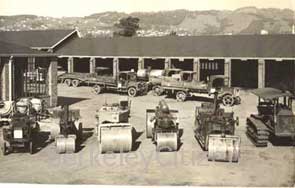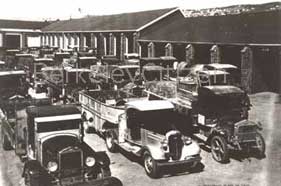
Walter H. Ratcliff
Berkeley Landmark Significance
|
|
1949 Berkeley Public Works Corporation Yard Map Click to enlarge Left side -- Right side City/Yard as the Contractor
Prior to 1913, road repairs, the construction of creek culverts, and garbage collection were performed by private contractors. Soon, the City of Berkeley began to look for ways to manage these growing costs. This issue was clearly reflected in an address made in 1917 by a mayoral candidate who stated, "At present, one of the heaviest of our expenses accounts is street work. Berkeley might well consider taking this work into her own hands. We can hire the same men, employ the same engineers, and buy the same materials at the same price."(18) The idea was that the profits could then be returned to the taxpayers. This is what began to happen as Berkeley, the contractor, began to work for Berkeley, the city. As a result, the Corporation Yard was developed to house these new municipal activities, i.e., staff, equipment, and materials.
Modern Streets Division, the Beginning of Public Works
In early 1917, a new Streets Division was organized at the Corporation Yard. (19) Before that time, Public Works activities centered around street cleaning and asphalt sweeping. These operations were expanded to include street work, and two gangs of workers with power rollers were organized. Eighty-five years ago, the idea of the City managing these services led to the creation of a more diversified municipal workforce and more maintenance activities performed by the City. The recently completed Ratcliff building, with its storeroom, sheds, and truck stalls, was first used to house the new Streets Division.
Corporation Yard street maintenance vehicles
Creation of Solid Waste Division/First Facility
The Corporation Yard was the site of another major shift in city operations. In 1921, the City assumed the activity of refuse collection for Berkeley. This new municipal task soon grew to dominate the Yard's activities until the mid-1980's when the Garbage Division (now the Solid Waste Management Division) moved to the Transfer Station at 2nd Street and Gilman in northwest Berkeley.
Creation of Fleet/Equipment Management
City of Berkeley's fleet of vehicles
Public Works Garbage Truck Fleet City Corporation Yard 1937
The Corporation Yard is the site of Berkeley's first fleet management. From 1915, when the first motorized vehicles and pieces of equipment were purchased, fleet management at the Yard has been an integral part of the City's operations. Historically, fleet management entailed more than auto maintenance. Because little equipment was available, or even made back then, staff often had to improvise innovative adaptations for vehicles and equipment in order to perform new municipal tasks. Today, the Public Works Department manages more than 500 vehicles and pieces of equipment.
All Rights Reserved



